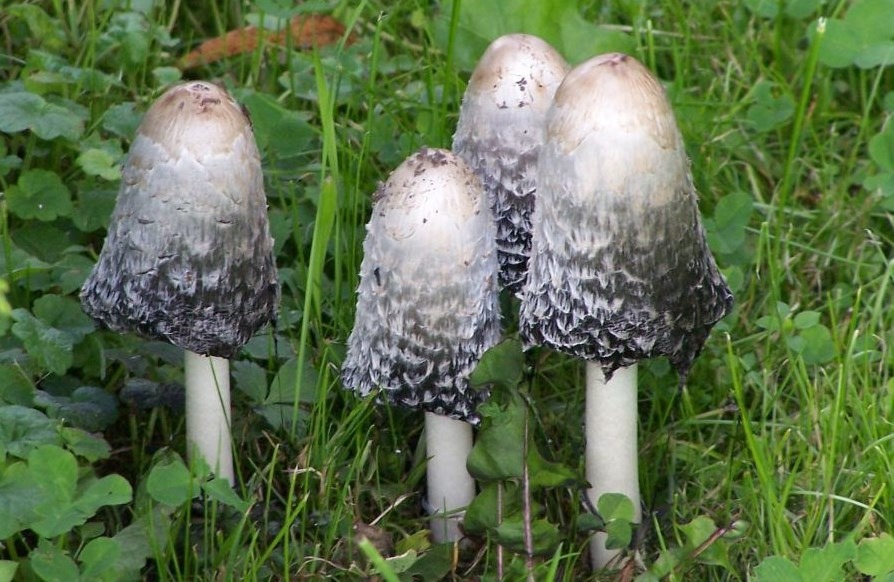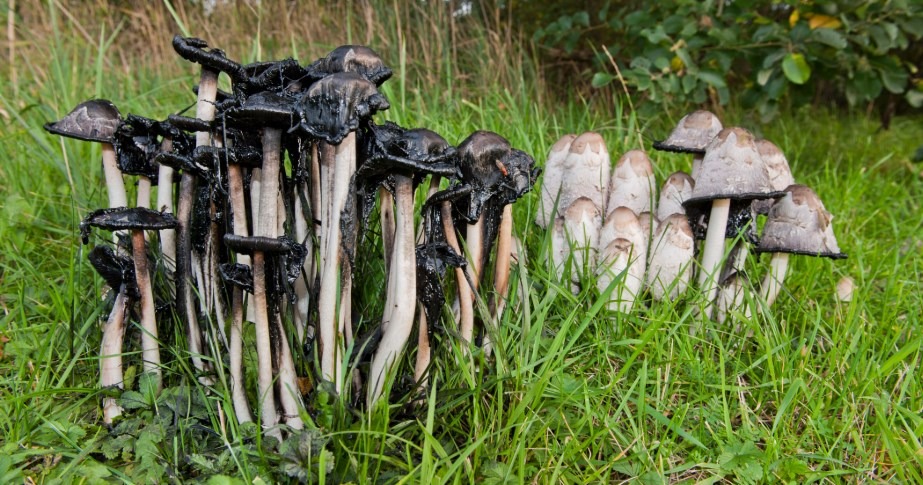The Coprinus comatus is one of the few edible mushrooms of the genus Coprinus. It belongs to the family of the Coprinaceae, to the order Agaricales and, more generally, to the class of the Basidiomycetes. It is also called shaggy ink cap.
Coprinus comatus is a typically saprophytic species, that is, it grows and nourishes of decomposing organic matter, both animal and vegetal.
The carpophore, that is, the fruiting body, when young, has a white colour. It has a very rapid ripening process that can last only one day. As an adult its flesh becomes deliquescent and it is possible to observe some black liquid dripping from the cap.

Introduction to Coprinus comatus
For this reason it is also called the “shaggy ink cap “.
In fact, it seems that in the past, from his hat, he made a liquid with which he prepared an ink even more resistant than india ink.
The phenomenon is called deliquescence, according to which a fruiting body, maturing, does not rot like all mushrooms normally do, but transforms into a blackish slurry; this phenomenon always starts from the gills and then extends to the whole cap. Only later on, it will affect also the stem.
This feature makes the mushroom easily identifiable.
Other details are: the numerous scales on the cap, the slender size, the slightly larger stipe at the base and the quick passage from the edible phase to the culinary inconsistency.
The species with the largest size in the genus Coprinus is the Coprinus picaceus, which can reach dimensions even up to 40 cm of length. It is not edible and the smell, which is often repellent, discourages its consumption.
Other Names of the Coprinus comatus
As anticipated in the previous paragraph, the Coprinus comatus, which in Latin means “endowed with a crown”, is also known with the name of shaggy ink cap , but also, Agaricus porcellanus, Agaricus tiphoides, lawyer’s wig, shaggy mane. In Italy they call it Coprino chiomato or Agaricus chiomato.
Description of shaggy ink cap
Let’s talk now about the physical and morphological characteristics of the Coprinus comatus.
Since in the adult phase, with the deliquescence of the cap and the gills, it takes on the characteristic liquid and black appearance, the common name well defines its appearance as an adult: shaggy ink cap.

Cap
The cap of the Coprinus comatus has dimensions going from the 4 to the 6 cm of diameter, in the lower part it has thick, compact and frail gills, when inserted with the stipe, they are free.
Initially they are white, then they go to pink, then to grey and black. Its shape of the cap of the coprinus fungus is cylindrical-ovoidal and then becomes conical-campanulate, often darker at the centre, with a typical star-shaped pattern.
It’s not very fleshy.
When young, the cuticle is white and dry and is covered by brownish-white scales that rise up with time and then becomes black. The cap opens like a bell and then turns into a sort of blackish liquid mush.
Stipe
The stipe of the Coprinus comatus is thin and slender and can measure from 1 to 3 cm. in diameter and reach a height of 25-30 cm. It is hollow inside and enlarged at the base.
On the stipe, often remain the remains of the membrane which initially has the function of protecting the young gills.
Flesh
The flesh of Coprino in the initial phase is firm, white and delicate.
The smell is of fresh coprinus comatus (however similar to other field mushrooms), is not well definable but pleasant. The taste is pleasant.
The shaggy ink cap is an excellent edible species, very tender and very fast cooking, with a strong taste and delicate at the same time. As already mentioned, it should be harvested when young when it is still completely white and consumed in the day.
Spores
The fungus is melanosporeous, that is, it has black spores, of ellipsoidal to ovoid shape, blackish in mass, smooth, with central germinative pore, dimensions 10-14 x 6,5-8,5 µm.
Habitat of Coprinus comatus
The shaggy ink cap is found isolated or, very often, in numerous groups, in fields, orchards, gardens, carry-over lands or, however, loose, sandy and calcareous.
Being a saprophyte, the substrate must be rich in organic substances. It prefers decomposing wood fragments, chips and sawdust.
Growth Periods of Coprinus comatus
The growth period of the coprinus comatus is preferably spring and autumn. It prefers humid environments and not very high temperatures. As already widely described, it is easy to perish because it goes from birth to deliquescence in a few hours.
When harvesting, it is advisable to remove the stipe from the cap to slow down the ripening process.
Mushrooms similar to the shaggy ink cap
Certainly similar to the Coprino comatus is the Coprinus ovatus, which, on the contrary, never has pink gills.
How to cook the Coprinus comatus
The shaggy ink cap, if very young, is certainly an excellent edible food. Since it is easily perishable, it must be consumed exclusively when young, when the gills are still white.
That’s why you have to cook in a simple way.
The mushroom coprinus is excellent raw, sautéed in a pan with a knob of butter, fried or stewed with chives and parsley.
It is not suitable for drying or deep-freezing because of the characteristics described above.
The consumption of some species, such as the Coprinus atramentarius and the Coprinus micaceus, cause serious cardiovascular problems, (coprinic syndrome) especially if taken with alcoholic substances, which can be not only drinks such as wine but also everything that contains alcohol, such as perfumes, aftershave and deodorants.compresi.
The effects may also occur several days later.
Therapeutic properties of Coprinus Mushroom
The Coprinus (Coprinus comatus) is used not only for food purposes, but also for therapeutic purposes.
It is rich in substances and is composed of 20-40% of proteins. It contains various vitamins: B3 group vitamins, vitamin C, vitamin D, vitamin E.
Shaggy ink cap contains many minerals such as potassium, calcium, vanadium, iron, copper, zinc and 20 amino acids, 8 of which are very important. It is therefore indicated in hyperglycemia, in the treatment of hemorrhoids and constipation.
Coprinus comatus promotes digestion and, according to recent studies, also seems to have antioxidant action and can be used as a support in the treatment of breast cancer.
IDENTITY CARD
CAP COLOR: White
STIPE HEIGHT: 5-18 cm
STIPE COLOR: white
FLESH: White
SMELL: Mild
TASTE: Mild
SPORE: Black
HABITAT: Grassy environments
- Ganoderma Lucidum
- Armillaria Mellea
- Amanita Caesarea
- Agaricus Bisporus
- Amanita Phalloides
- Coriolus Versicolor
- Flammulin Velutipes
- Marasmius Oreades
- Pleurotus Ostreatus
- Agaricus Campestris
- Macrolepiota procera